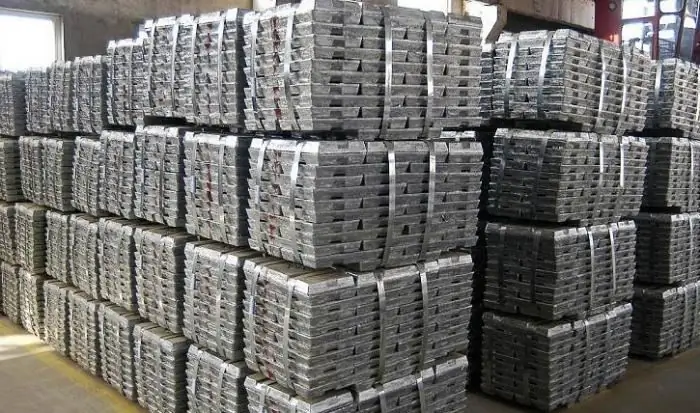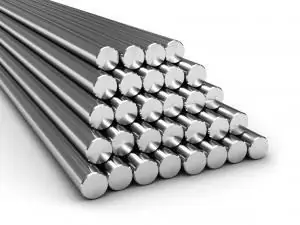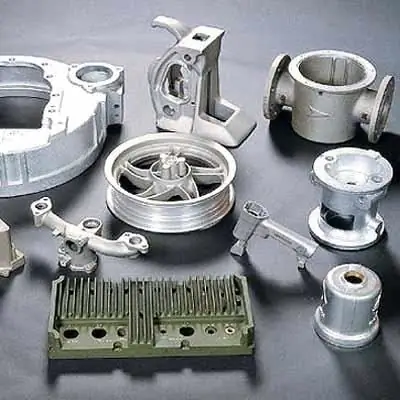2026 Author: Howard Calhoun | [email protected]. Last modified: 2025-01-24 13:10:45
Expertise of metals is used in judicial practice, in investigating the causes of accidents, as well as for making responsible technical decisions in the manufacture of various objects. A feature of metals and alloys is that they well "retain" the parameters of the previous states that arose under the influence of external factors (mechanical loads, thermal effects, and others). This property allows you to set the conditions that precede an event and identify a causal relationship.
Tasks

All tasks of metallurgical expertise can be combined into 3 large groups:
- Classification - determination of belonging to any type (type of metal or alloy, grade, scope; deposit from which the material was extracted; compliance with the requirements of the drawing and other technical documentation).
- Identification individual: determination of the whole in parts (by signs of elemental composition and structure, traces of processing and other parameters), belonging to a common production batch, establishingsource - equipment or manufacturer; group - identification of identical properties of metals and alloys by particular features (characteristic impurities, crystal structure, mechanical properties, nature of destruction, surface condition: oxidation, corrosion, scratches, etc.).
- Diagnostic: establishing the fact of interaction with a metal part, the causes and features of the destruction process, determining the manufacturing technology, the type of devices on which the metal product was made, identifying deviations from the requirements of the technical regulation.
Objects

The following micro- and macro-subjects can serve as objects of examination of metal products:
- steel parts, blanks, wire and wires, metal hoses, cables, pipes;
- melting on wires and other metal products;
- details of vehicles and technological equipment destroyed as a result of the accident;
- knives (factory and home-made) and other edged weapons;
- fragments or parts of explosive devices;
- solders;
- jewellery, precious metals and native gold;
- metallization traces;
- household items.
Steps
Examination of metals and alloys is carried out according to the following scheme for determining characteristics:
- material nature (density, ferromagnetism, color, hardness, metallic luster, electrical conductivity, interaction with acids);
- geometric anddesign features (size, shape, presence of metallic and non-metallic coatings);
- production technology and equipment;
- operating conditions (wear, corrosion, etc.);
- features of destruction (melting, deformation, shock or static loads, erosion, a combination of several factors);
- classification type and scope;
- microstructure;
- physical and mechanical properties, chemical composition.
Depending on what questions are put before the examination, the construction of the examination methodology depends. Since some methods of study require the destruction of the object under study, it is necessary to clearly establish the purpose of the study.
Metal Forensics

Forensic examinations are conducted to address the following most common issues:
- determining the brand of metal from which the crime weapon was made;
- identifying the type of gold - native or industrial;
- presence of metal particles on another object;
- determining the authenticity of a coin or medal, as well as their age;
- detection of the type and duration of exposure to the metal;
- reasons for the destruction of a metal part or assembly (to develop a conclusion in emergency situations, fires);
- determining the identity of the part and the main metal part / structure, as well as the method by which they were separated and others.
Optical and scanning microscopy
Microscopic examination of surfaces is done at the initial stage of metallurgical expertise. Examination of metals and alloys reveals the features formed in the process of manufacturing and operation of parts and assemblies. To carry out this work, scanning and transmission electron microscopes are used.
One of the types of such examination is fractography - a microscopic study of fracture surfaces to establish cause-and-effect relationships between signs of damage and external or internal factors that caused the destruction.
Chemical composition research

The most common method for studying the chemical composition of metals and alloys is emission spectral analysis (ESA), which is based on the features of the emission spectrum of atoms of matter in the optical range of electromagnetic waves. Light emission is excited by a spark discharge between the studied metal object and the auxiliary electrode.
This method allows you to determine a chemical element in the presence of its smallest amount (up to 10-4%), which is used in the analysis of trace amounts on both metallic and non-metallic contacting material. This technique is also used in the examination of the quality of the metal to identify microimpurities that are not regulated by the technical specifications for the manufacture of this object.
Non-destructive and classical research methods
If research needs to be donenon-destructive method, then it is done using X-ray fluorescence analysis. This technology involves exposure of the material to X-rays, which cause fluorescent radiation in the surface layer. Each atomic number of the periodic system of chemical elements has its own wavelength. This technique helps to determine both qualitative and quantitative composition.
Examination of metals can be carried out in classical ways. They take longer and require a significant amount of sampling. These methods include:
- qualitative chemical reactions;
- colorimetric analysis;
- polarography;
- conductometry (measurement of electrical conductivity of solutions) and others.
Microstructure research

Structural metallography is used to determine the nature and number of phases in the examination of non-ferrous metals, steel, cast iron and other metals. The study is carried out by the method of powder x-ray diffraction. The sample is ground into powder, a monochromatic X-ray beam is directed at it, and an image is obtained in the form of rings on a photographic film rolled around the object under study. The presence of a certain texture is revealed by the change in the intensity of the lines.
Special X-ray diffractometers are used to study powder X-ray patterns. They can also be used to obtain information about the crystal structure of the metal. ATin practical terms, this is used to determine the type of heat treatment.
Determination of the phase composition is necessary to identify the general parameters of the parts of the object under study. Such a study, for example, allows you to get information about what was primary - a short circuit or a fire (copper contacts), whether a lamp with a tungsten filament burned at the time of its destruction, and solve other issues.
To detect thin films of oxides, carbides, chlorides, sulfides and other s alts on the surface of metal products, an electron diffraction method is used. It is based on the diffraction of a stream of moving electrons, the wavelength of which is shorter than that of X-rays. The analysis of metals and alloys is carried out in vacuum electron diffraction machines, which can also produce electron-optical shadow images.
Mechanical properties

To determine the physical and mechanical properties of metals and alloys, the following test methods are used:
- for tension/compression (determination of tensile strength, elasticity, flow and other characteristics);
- bending;
- for hardness and microhardness;
- heating to find the temperature of phase transformations, thermal conductivity and linear expansion.
Such methods are usually used in combination when investigating the causes of accidents and the destruction of metal parts and assemblies.
Expert opinion

After the examination of metals, the specialist issues a conclusion that contains the following information:
- general data (title of the research paper, start and end date, place of examination, grounds for its execution, information about the expert, questions asked);
- methods used and general scientific patterns on the basis of which the work was done;
- normative documents and other sources;
- data obtained during the study of the object;
- conclusions (or reasons why a definite answer cannot be given).
Examples
Examples of expert opinion include the following:
- destruction of the part occurred as a result of the action of a static bending load acting simultaneously;
- the breakdown of the assembly was two-stage: after a single dynamic load, a crack formed, which, as a result of fatigue stresses, increased by 80%; the object is divided into parts under the action of a static tensile load along the area weakened by this crack;
- the destruction of the vessel occurred along the weld, which was weakened by a defect obtained during welding (lack of penetration of the root of the seam), at the time of the start of operation, the object no longer had the necessary strength;
- the failure of the structure was instantaneous, by riveting, the reason is the impact of a dynamic load, the value of which exceeds the strength laid down in the design documentation.
From cases of judicial practice,illustrating the application of the examination of metals, we can cite the following: a metal fragment was found in the body of the murdered. It was necessary to establish which of the 3 knives it is part of. Spectral analysis showed that the composition of the fragment coincided with that of one of the knives. The microstructure of the piece of metal differed from all the blades, but during the examination it was proved that the blade was sharpened on an electric grinder without cooling, as a result of which these changes occurred.
Laboratories
An independent examination of the metal can be carried out by laboratories with state accreditation. The accreditation certificate must indicate in which field of activity permission was obtained to conduct research, test methods and regulatory documents on the basis of which they are carried out, as well as the minutes of the meeting of the accreditation commission.
In the Moscow Region, such services are provided by Metall-Expertise, the Interregional Center for Expertise and Evaluation (ICEA), the Federation of Forensic Experts and other organizations.
Recommended:
Ferrous metals: deposits, storage. Metallurgy of ferrous metals

Metals are materials that never lose their relevance. They are widely used in household and industry
Heat-resistant alloys. Special steels and alloys. Production and use of heat-resistant alloys

Modern industry cannot be imagined without such material as steel. We encounter it at almost every turn. By introducing various chemical elements into its composition, it is possible to significantly improve the mechanical and operational properties
Precious metals quotes at Sberbank. Precious metals (Sberbank): prices

One of the most profitable investments is the purchase of precious metals such as gold, silver, platinum, palladium. This has been the case for many years and remains so today. In times of economic crisis, this option is even more relevant
Aluminum alloys: properties and processing of metals

Aluminum alloys are very often used in construction, industry and other manufacturing industries. However, before using them, it is necessary to learn about the properties of alloys, as well as about the features of their processing
Alloy metals: description, list and application features

Development is identified with improvement. Improving industrial and domestic capabilities is carried out through the use of materials with progressive characteristics. These are, in particular, alloyed metals. Their diversity is determined by the possibility of correcting the quantitative and qualitative composition of alloying elements

